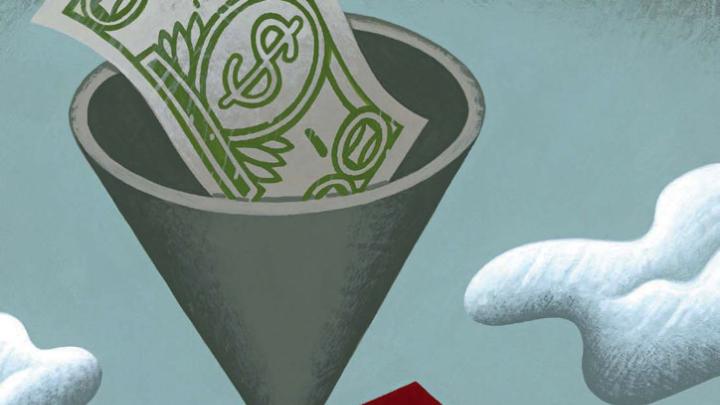G
etting ahead—or getting by—is increasingly difficult in the United States without a college degree. The demand for college education is at an all-time high, but so is the price tag. David Deming—professor of public policy at the Kennedy School and professor of education and economics at the Graduate School of Education—wants to ease that tension by reallocating government spending on higher education to make public colleges tuition-free.
Deming’s argument is elegant. Public spending on higher education is unique among social services: it is an investment that pays for itself many times over in higher tax revenue generated by future college graduates, a rare example of an economic “free lunch.” In 2016 (the most recent year for which data are available), the United States spent $91 billion subsidizing access to higher education. According to Deming, that spending isn’t as progressive or effective as it could be. The National Center for Education Statistics indicates that it would cost roughly $79 billion a year to make public colleges and universities tuition-free. So, Deming asks, why not redistribute current funds to make public colleges tuition-free, instead of subsidizing higher education in other, roundabout ways?
Of the estimated $91 billion the nation spends annually on higher education, $37 billion go to tax credits and tax benefits. These tax programs ease the burden of paying for both public and private colleges, but disproportionately benefit middle-class children who are probably going to college anyway. Instead of lowering costs for those students, Deming points out, a progressive public-education assistance program should probably redirect funds to incentivize students to go to college who wouldn’t otherwise consider it.
Another $13 billion in federal spending subsidize interest payments on student loans for currently enrolled undergraduates. And the remaining $41 billion go to programs that benefit low-income students and military veterans, including $28.4 billion for Pell Grants and similar programs. Pell Grants are demand-side subsidies: they provide cash directly to those who pay for a service, i.e., students; supply-side subsidies (see below) channel funds to suppliers, such as colleges. Deming asserts that Pell Grant money, which travels with students, voucher-style, is increasingly gobbled up by low-quality, for-profit colleges. These colleges are often better at marketing their services than at graduating students or improving their graduates’ prospects, despite being highly subsidized by taxpayers. “The rise of for-profit colleges has, in some ways, been caused by disinvestment in public higher education. Our public university systems were built for a time when 20 percent of young people attended college,” says Deming. “Now it’s more like 60 percent, and we haven’t responded by devoting more resources to ensuring that young people can afford college and succeed when they get there.” As a result, an expensive, for-profit market has filled the educational shortage that government divestment has caused.
The vast majority of states have continuously divested in public education in recent decades, pushing a higher percentage of the cost burden of schools onto students. Deming believes this state-level divestment is the main reason for the precipitous rise in college tuition, which has outpaced the rest of the Consumer Price Index for 30 consecutive years. (Compounding reasons include rising salaries despite a lack of gains in productivity—a feature of many human-service-focused industries such as education and healthcare.) Against this backdrop, Deming writes, “at least some—and perhaps all—of the cost of universal tuition-free public higher education could be defrayed by redeploying money that the government is already spending.” (The need for some funding programs would remain, however, given the cost of room, board, books, and other college supplies.)
Redirecting current funding to provide tuition-free public-school degrees is only one part of Deming’s proposal. He knows that making public higher education free could hurt the quality of instruction by inciting a race to the bottom, stretching teacher-student ratios and pinching other academic resources. He therefore argues that any tuition-free plan would need to be paired with increased state and federal investment, and programs focused on getting more students to graduate. Because rates of degree completion strongly correlate with per-student spending, Deming proposes introducing a federal matching grant for the first $5,000 of net per-student spending in states that implement free college. “Luckily,” he says, “spending more money is a policy lever we know how to pull.”
Deming argues that shifting public funding to supply-side subsidies, channeled directly to public institutions, could nudge states to reinvest in public higher education. Such reinvestment would dampen the demand for low-quality, for-profit schools; increase college attendance in low-income communities; and improve the quality of services that public colleges and universities could offer. Early evidence of these positive effects has surfaced in some of the areas that are piloting free college-tuition programs, including the state of Tennessee and the city of Kalamazoo, Michigan.
Higher education is an odd market because buyers (students) often don’t have good information about school quality and it’s a once-in-a-lifetime decision. Creating a supply-side subsidy system would take some freedom of choice away from prospective undergraduates who want government funding for private, four-year degrees. But, for Deming, that’s a trade-off worth making, if the state is better able to measure the effectiveness of certain colleges and allocate subsidies accordingly. Education is more than the mere acquisition of facts—which anyone can access freely online—because minds, like markets, learn best through feedback. Quality feedback is difficult to scale well without hiring more teachers and ramping up student-support resources. That’s why Deming thinks it’s high time for the public higher-education market to get a serious injection of cash.








